Figure 25-27 : Effect of adsorbent dose on the Fast green biosorption by BGH, TDH and
TH respectively (♦ 10 mg/L ■ 20 mg/L ▲ 50 mg/L)
 Figure : 25 Figure : 25 |
 Figure : 26 Figure : 26 |
 Figure : 27
Figure : 27
Figure 28-30 : Effect of adsorbent dose on the Rhodamine B biosorption by BGH, TDH and
TH respectively (♦ 10 mg/L ■ 20 mg/L ▲ 50 mg/L)
 Figure : 28 Figure : 28 |
 Figure : 29 Figure : 29 |

Figure : 30
| 4.3.3 Effect of pH |
 |
The effect of pH on adsorption of various dyes at different initial dye concentrations is given in Tables and Figures. The adsorption of amaranth by bengal gram husk; tur dal husk and tamarind husk is given in Figures 31 to 33 and Tables 27 to 29. pH effects on Methylene blue by bengal gram husk, tur dal husk and tamarind husk are given in Tables 30-32 and Figures 34 to 36 respectively. Fast green adsorption by the three husks is given in Tables 33 to 35 and Figures 37 to 39. pH effects on Rhodamine B by bengal gram husk, tur dal husk and tamarind husk are given in Tables 36-38 and Figures 40 to 42 respectively.
The maximum percentage of anionic dyes namely amaranth and fast green was biosorbed at pH 2.0. Methylene blue exhibited an optimum range of 6-11 and rhodamine B was adsorbed at pH 7-11.
Figure 31-33 : Effect of pH on the Amaranth biosorption by BGH, TDH and
TH respectively
(♦ 10 mg/L ■ 20 mg/L ▲ 50 mg/L)
 Figure : 31 Figure : 31 |
 Figure : 32 Figure : 32 |
 Figure : 33
Figure : 33
Figure 34-36 : Effect of pH on the Methylene blue biosorption by BGH, TDH and TH respectively
(♦ 10 mg/L ■ 20 mg/L ▲ 50 mg/L)
 Figure : 34 Figure : 34 |
 Figure : 35 Figure : 35 |
 Figure : 36
Figure : 36
Figure 37-39 : Effect of pH on the Fast green biosorption by BGH, TDH and TH respectively
(♦ 10 mg/L ■ 20 mg/L ▲ 50 mg/L)
 Figure : 37 Figure : 37 |
 Figure : 38 Figure : 38 |
 Figure : 39
Figure : 39
Figure 40-42 : Effect of pH on the Rhodamine B biosorption by BGH, TDH and TH respectively
(♦ 10 mg/L ■ 20 mg/L ▲ 50 mg/L)
 Figure : 40 Figure : 40 |
 Figure : 41 Figure : 41 |
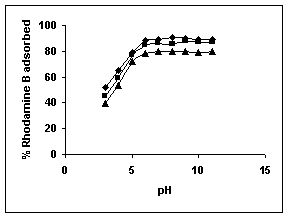
Figure : 42
Table 27 : Effect of pH and initial dye ion concentration on
Amaranth adsorption by Bengal gram husk (Adsorbent dose = 0.25g/100ml)

Table 28 : Effect of pH and initial dye ion concentration on
Amaranth adsorption by Tur dal husk (Adsorbent dose = 0.3g/100ml)
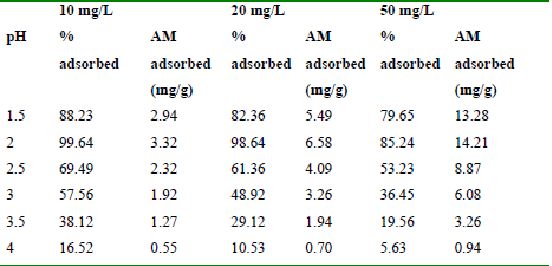
Table 29 : Effect of pH and initial dye ion concentration on
Amaranth adsorption by tamarind husk (Adsorbent dose = 0.25g/100ml)

Table 30 : Effect of pH and initial dye ion concentration on
Methylene Blue adsorption by bengal gram husk (Adsorbent dose = 0.15g/100ml)

Table 31 : Effect of pH and initial metal ion concentration on
Methylene Blue adsorption by Tur dal husk (Adsorbent dose = 0.1g/100ml)

Table 32 : Effect of pH and initial dye ion concentration on
Methylene blue adsorption by tamarind husk (Adsorbent dose = 0.2 g/100ml)

Table 33 : Effect of pH and initial metal ion concentration on
Fast green adsorption by bengal gram husk (Adsorbent dose = 0.3g/100ml)

Table 34 : Effect of pH and initial dye ion concentration on
Fast green adsorption by Tur dal husk (Adsorbent dose = 0.15g/100ml)

Table 35 : Effect of pH and initial dye ion concentration on
Fast green adsorption by Tamarind husk (Adsorbent dose = 0.3g/100ml)

Table 36 : Effect of pH and initial dye ion concentration on
Rhodamine B adsorption by bengal gram husk (Adsorbent dose = 0.35g/100ml)
Table 37 : Effect of pH and initial dye ion concentration on
Rhodamine B adsorption by tur dal husk (Adsorbent dose = 0.5g/100ml)

Table 38 : Effect of pH and initial dye ion concentration on
Rhodamine B adsorption by tamarind husk (Adsorbent dose = 0. 4g/100ml)

4.3.4 Adsorption Isotherms
Langmuir adsorption isotherms for amaranth adsorption by bengal gram husk, Tur dal husk and tamarind husk in Figures 43 to 45. Langmuir isotherms for methylene blue adsorption by the three adsorbents in Figures 46-48 and Figures 49 to 51 present the Langmuir isotherms for fast green adsorption. Langmuir plots for rhodamine B adosrption by BGH, TDH and TH are presented in Figures 52 to 54. The linear plots between Ceq vs Ceq/q shows that the three adsorbents namely BGH, TDH and TH followed Langmuir adsorption isotherm.
Figure 43-45 : Langmuir adsorption isotherm for Amaranth by BGH, TDH and TH respectively
 Figure : 43 Figure : 43 |
 Figure : 44 Figure : 44 |
 Figure : 45
Figure : 45
Figure 46-48 :Langmuir adsorption isotherm for Methylene blue by BGH, TDH and TH respectively
 Figure : 46 Figure : 46 |
 Figure : 47 Figure : 47 |

Figure : 48
Figure 49-51 : Langmuir adsorption isotherm for Fast green by BGH, TDH and TH respectively
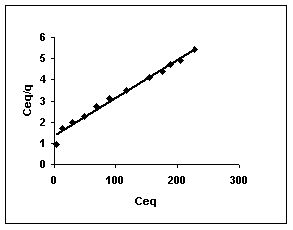 Figure : 49 Figure : 49 |
 Figure : 50 Figure : 50 |

Figure : 51
Figure 52-54 : Langmuir adsorption isotherm for Rhodamine B by BGH, TDH and TH respectively
 Figure : 52 Figure : 52 |
 Figure : 53 Figure : 53 |

Figure : 54
The Freundlich plots for amaranth biosorption by the three husks namely BGH, TDH and TH are given in Figures 55 to 57, methylene blue adsorption in Figures 58 to 60; fast green biosorption in Figures 61 to 63 and rhodamine B adsorption by the three husks are given in Figures 64 to 66. The adsorption of dyes by the three husks namely BGH, TDH and TH followed Freundlich isotherms.
Figure 55-57 : Freundlich adsorption isotherm for Amaranth by BGH, TDH and TH respectively
 Figure : 55 Figure : 55 |
 Figure : 56 Figure : 56 |
 Figure : 57
Figure : 57
Figure 58-60 : Freundlich adsorption isotherm for Methylene blue by BGH, TDH and TH respectively
 Figure : 58 Figure : 58 |
 Figure : 59 Figure : 59 |
 Figure : 60
Figure : 60
Figure 61-63 : Freundlich adsorption isotherm for Fast green by BGH, TDH and TH respectively
 Figure : 61 Figure : 61 |
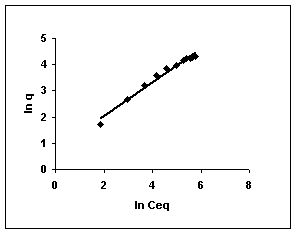 Figure : 62 Figure : 62 |

Figure : 63
Figure 64-66 : Freundlich adsorption isotherm for Rhodamine B by BGH, TDH and TH
 Figure : 64 Figure : 64 |
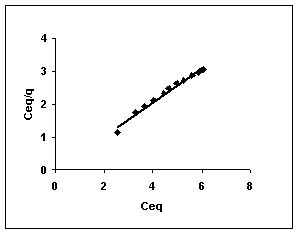 Figure : 65 Figure : 65 |
 Figure : 66
Figure : 66
Table 39 : Sorption isotherm constants and coefficients of determination for adsorption of dyes by TDH

Table 40 : Sorption isotherm constants and coefficients of determination adsorption of dyes for BGH

Table 41 : Sorption isotherm constants and coefficients of determination for adsorption of dyes by TH
Table 42 : Equilibrium parameter (RL) for adsorption of dyes
| Adsorption kinetics |
 |
Lagergren plots of log10 (qe-q) vs t for the adsorption of The Lagergren plots are shown in Figures 67 to 75 for adsorption of amaranth by BGH, TDH and TH; Figures 67 to 69 give the Lagergren plots for adsorption of methylene blue by BGH, TDH and TH respectively; Figures 70 to 72 present the Lagergren plots for adsorption of fast green and Figures 73 to 75 give the Lagergren plots and their rate constants for rhodamine B adsorption.
The rate constants that are derived from the Langergren equation are given dyes in Tables
43-53 for dyes. The linear plots of log10 (qe-q) vs t show that the adsorption follows a pseudo first order reaction.
Figure 67-69 : Lagergren plots for Amaranth adsorption by BGH, TDH and TH respectively
(♦ 10 mg/L ■ 20 mg/L ▲ 50 mg/L ● 100mg/L)
 Figure : 67 Figure : 67 |
 Figure : 68 Figure : 68 |
 Figure : 69
Figure : 69
Figure 70-72 : Lagergren plots for Methylene blue adsorption by BGH, TDH and TH respectively
(♦ 10 mg/L ■ 20 mg/L ▲ 50 mg/L ● 100mg/L)
 Figure : 70 Figure : 70 |
 Figure : 71 Figure : 71 |
 Figure : 72
Figure : 72
Figure 73-75 : Lagergren plots for Fast green adsorption by BGH, TDH and TH respectively
(♦ 10 mg/L ■ 20 mg/L ▲ 50 mg/L ● 100mg/L)
 Figure : 73 Figure : 73 |
 Figure : 74 Figure : 74 |
 Figure : 75
Figure : 75
Figure 76-78 : Lagergren plots for Rhodamine B adsorption by BGH, TDH and TH respectively
(♦ 10 mg/L■ 20 mg/L▲50 mg/L ●100mg/L)
 Figure : 76 Figure : 76 |
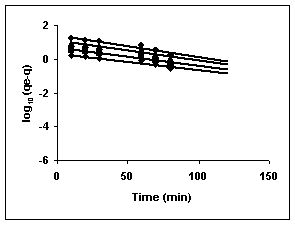 Figure : 77 Figure : 77 |
 Figure : 78
Figure : 78
Table 43 : Effect of initial Amaranth concentration on
Lagergren rate constant by Tur dal husk (Adsorbent dose-0.3g/100 mL; pH – 2.0)

Table 44 : Effect of initial Amaranth concentration on
Lagergren rate constant by Tamarind husk (Adsorbent dose-0.25g/100 mL; pH – 2.0)

Table 45 : Effect of initial Methylene Blue concentration on
Lagergren rate constant by bengal gram husk (Adsorbent dose-0.15g/100 mL; pH – 9.0)

Table 46 : Effect of initial Methylene Blue concentration on
Lagergren rate constant by Tur dal husk (Adsorbent dose-0.10 g/100 mL; pH – 9.0)

Table 47 : Effect of initial Methylene Blue concentration on
Lagergren rate constant by tamarind husk (Adsorbent dose-0.2 g/100 mL; pH – 9.0)

Table 48 : Effect of initial Fast green concentration on
Lagergren rate constant by bengal gram husk (Adsorbent dose-0.30g /100 mL; pH – 2.0)

Table 49 : Effect of initial Fast green concentration on
Lagergren rate constant by Tur dal husk (Adsorbent dose-0.15g/100 mL; pH – 2.0)

Table 50 : Effect of initial Fast green concentration on
Lagergren rate constant by Tamarind husk (Adsorbent dose-0.30g/100 mL; pH – 2.0)
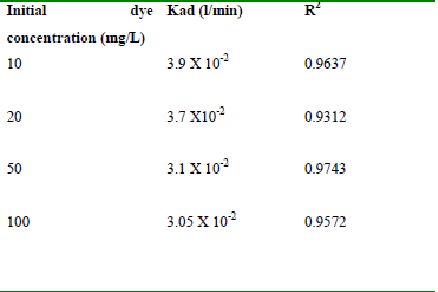
Table 51 : Effect of initial Rhodamine B concentration on
Lagergren rate constant by bengal gram husk (Adsorbent dose-0.35g/100 mL; pH – 8.0)

Table 52 : Effect of initial Rhodamine B concentration on
Lagergren rate constant by Tur dal husk (Adsorbent dose-0.5g/100 mL; pH – 8.0)

Table 53 : Effect of initial Rhodamine B concentration on
Lagergren rate constant by Tamarind husk (Adsorbent dose-0.4g /100 mL; pH – 2.0)
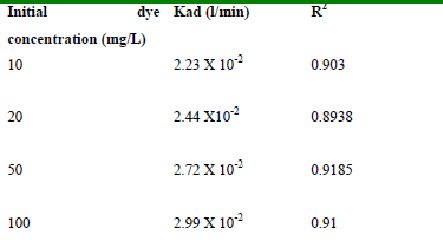
4.3.6 Desorption studies
Figure 79-82 presents the desorption of dyes –Amaranth, Methylene blue, Fast green and Rhodamine B by BGH, TDH, and TH at different initial pH.
Among the dyes, methylene blue was desorbed the least and amaranth the most. Among the adsorbents, the maximum amount of dyes was desorbed from tamarind husk.
Figure 79-82 : Effect of pH on the desorption of Amaranth, Methylene Blue, Fast green and
Rhodamine B (• BGH■ TDH▲TH)
 Figure : 79 Figure : 79 |
 Figure : 80 Figure : 80 |
 Figure : 81 Figure : 81 |
 Figure : 82 Figure : 82 |







 Figure : 6
Figure : 6 Figure : 7
Figure : 7
 Figure : 9
Figure : 9 Figure : 10
Figure : 10 
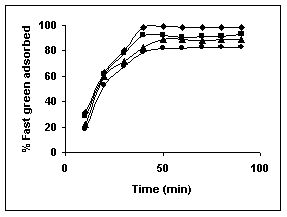 Figure : 12
Figure : 12  Figure : 13
Figure : 13 
 Figure : 16
Figure : 16  Figure : 17
Figure : 17 













 Figure : 19
Figure : 19  Figure : 20
Figure : 20 
 Figure : 22
Figure : 22  Figure : 23
Figure : 23
 Figure : 25
Figure : 25  Figure : 26
Figure : 26 
 Figure : 28
Figure : 28  Figure : 29
Figure : 29 

 Figure : 31
Figure : 31  Figure : 32
Figure : 32 
 Figure : 34
Figure : 34  Figure : 35
Figure : 35 
 Figure : 37
Figure : 37  Figure : 38
Figure : 38 
 Figure : 40
Figure : 40  Figure : 41
Figure : 41 












 Figure : 43
Figure : 43  Figure : 44
Figure : 44 
 Figure : 46
Figure : 46  Figure : 47
Figure : 47 
 Figure : 49
Figure : 49  Figure : 50
Figure : 50 
 Figure : 52
Figure : 52  Figure : 53
Figure : 53 
 Figure : 55
Figure : 55  Figure : 56
Figure : 56 
 Figure : 58
Figure : 58 Figure : 59
Figure : 59 
 Figure : 61
Figure : 61  Figure : 62
Figure : 62 
 Figure : 64
Figure : 64  Figure : 65
Figure : 65 





 Figure : 67
Figure : 67  Figure : 68
Figure : 68 
 Figure : 70
Figure : 70  Figure : 71
Figure : 71 
 Figure : 73
Figure : 73  Figure : 74
Figure : 74 
 Figure : 76
Figure : 76  Figure : 77
Figure : 77 











 Figure : 79
Figure : 79 Figure : 80
Figure : 80  Figure : 81
Figure : 81  Figure : 82
Figure : 82 

